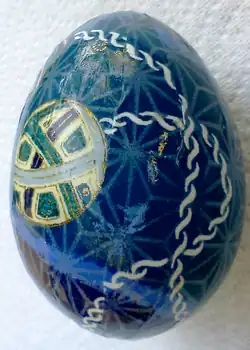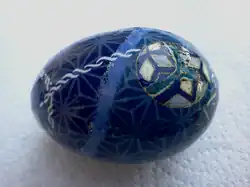Washi egg


A washi egg is a decorated egg commonly created at Easter, using Japanese washi paper (as used for origami), glue, and varnish. Washi eggs are made into ornaments and decorations.
Technique
A washi egg is made by first blowing the egg to remove its contents. A rectangle of washi paper large enough to cover the egg is folded in half, and cut nearly to the midline every quarter inch (6 mm) to form a fringe of narrow strips. Each strip is trimmed to a point. The paper is unfolded, rolled around the egg, and glued on, a strip at a time; the strips overlap at the ends of the egg. The egg may then be varnished.[1]
Classes are given on US bases in Japan according to the Okinawan English language newspaper Japan Update.[2]
See also
References
- ^ "How to make Washi eggs". DeviantArt. Archived from the original on January 31, 2012. Retrieved January 1, 2012.
- ^ Japan Update Archived 2012-05-28 at the Wayback Machine. Japanese art lends beauty to Easter holiday. 15 April 2004. Retrieved 1 January 2012.
- Robertta A. Uhl (March 15, 2007), Japanese Washi Paper Crafts. Tuttle Publishing. 978-0804838139.
- Peggy Landers Rao & Jean Mahoney (October 15, 1997), Japanese Accents in Western Interiors. Japan Publications Trading. 978-0870409882.
External links
- Washi Eggs (How to Make) Archived 2015-05-13 at the Wayback Machine
- Yasutomo: Washi Eggs
- Martha Stewart: Elegant Eggs April 2004.